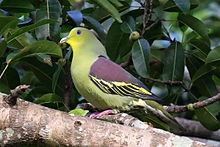- Pompadour Green Pigeon
-
Pompadour Green Pigeon 
Male of the nominate subspecies in the Kaudulla National Park, Sri Lanka. Conservation status Scientific classification Kingdom: Animalia Phylum: Chordata Class: Aves Order: Columbiformes Family: Columbidae Genus: Treron Species: T. pompadora Binomial name Treron pompadora
(Gmelin, 1789)Synonyms Osmotreron aromatica
Osmotreron axillarisThe Pompadour Green Pigeon (Treron pompadora) is a pigeon in the genus Treron. It is widespread in forests of southern and southeast Asia. It has several distinctive subspecies, and some authorities split the Pompadour Green Pigeon into multiple species.
Contents
Distribution and habitat
It is a widespread resident bird in forests of tropical southern Asia from India, Sri Lanka east to the Philippines and the Moluccas. In India, they are found as disjunct populations in the Western Ghats, some parts of the Eastern Ghats, Northeastern India and in the Andaman Islands. It remains fairly common in large parts of its range, so its conservation status is evaluated as Least Concern by the IUCN.[1]
Taxonomy
The distribution of the Pompadour Green Pigeon is peculiarly disjunct and several of its subspecies are distinctive, leading some authorities to split it into six species:[2][3]
- Sri Lanka Green Pigeon (Treron pompadora) from Sri Lanka. Monotypic.
- Grey-fronted Green Pigeon (Treron affinis) from the Western Ghats in India. Monotypic.
- Andaman Green Pigeon (Treron chloropterus) from the Andamans and Nicobars. Monotypic.
- Ashy-headed Green Pigeon (Treron phayrei) from northeast India and Nepal, east to Yunnan in China, and south through Indochina (north of the Isthmus of Kra). Commonly considered monotypic, though some recognize the subspecies conoveri.
- Philippine Green Pigeon (Treron axillaris) from the Philippines. Includes the subspecies amadoni, canescens and everetti.
- Buru Green Pigeon (Treron aromaticus) from small islands in the Flores Sea and Buru, Indonesia. Monotypic.
Description
The Pompadour Green Pigeon is a stocky, medium-sized pigeon, 25 to 28 centimetres (9.8 to 11 in) in length, with some subspecies significantly larger than others (e.g., chloropterus is significan larger than the subspecies from the Asian mainland).[3] The head is green to greenish-yellow, and the underparts are green, though males of the subspecies phayrei have a pale orange patch on the chest. The crown, including the forehead is grey, except in the nominate subspecies where the forehead is greenish-yellow.[3] The undertail coverts are mainly whitish or pale yellowish, though they are deep cinnamon in males of affinis and phayrei. The wings are blackish with distinct yellow edging to the wing coverts and tertials. The mantle is dark green in the female and deep purplish-chestnut in the male. In most subspecies, this includes the "shoulder", but in males of aromaticus the "shoulder" is very dark grey and in males of chloropterus it is green.[4] Furthermore, males of aromaticus and some members of the axillaris group have a grey band above the mantle.[4]
The legs are reddish in most subspecies, but grey in the axillaris group. The eyes are maroon-red or deep to very light blue (depends on subspecies), and the bill is whitish-grey with a dull, pale greenish or bluish base, except in the axillaris group where the base is red.
Behaviour
The Pompadour Green Pigeon usually occurs singly or in small groups. Its flight is fast and direct, with the regular beats and an occasional sharp flick of the wings that are characteristic of pigeons in general. It eats the seeds and fruits of a wide variety of plants. It builds a stick nest in a tree and lays two white eggs.
In culture
In Sri Lanka, this bird and several others green pigeon are known as Bata Goya in the Sinhala language.[5]
References
- ^ a b "Treron pompadora". IUCN Red List of Threatened Species. Version 2010.4. International Union for Conservation of Nature. 2009. http://www.iucnredlist.org/apps/redlist/details/143625. Retrieved 18 November 2010.
- ^ Gill, F., and D. Donsker (Eds). 2010. IOC World Bird Names. Version 2.6. Accessed 18 November 2010.
- ^ a b c Rasmussen, P.C. & J.C. Anderton. 2005. Birds of South Asia: the Ripley guide. 2 vols. Lynx Edicions, Barcelona.
- ^ a b Gibbs, D.; Barnes , E.; and Cox, J. (2000). Pigeons and Doves: A Guide to the Pigeons and Doves of the World. ISBN 1873403607.
- ^ Anonymous (1998). "Vernacular Names of the Birds of the Indian Subcontinent" (PDF). Buceros 3 (1): 53–109. http://www.bnhsenvis.nic.in/pdf/vol%203%20(1).pdf.
- Grimmett, R.; Inskipp, C.; and Inskipp, T.. Birds of India. ISBN 0-691-04910-6.
Categories:- IUCN Red List least concern species
- Treron
- Birds of Southeast Asia
- Birds of Bangladesh
- Birds of Burma
- Birds of Laos
- Birds of Vietnam
- Birds of Cambodia
- Birds of Thailand
- Birds of Malaysia
- Birds of Asia
- Birds of Bhutan
- Birds of China
- Birds of India
- Birds of Nepal
- Birds of Sri Lanka
- Animals described in 1789
Wikimedia Foundation. 2010.





